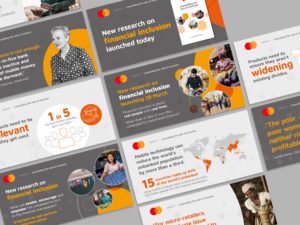We love microcontent. A lot. It’s simple, easy to do and effective. In this article we introduce you to microcontent, the various formats in which it comes, why you should use it and how you can get started.
What is microcontent?
Microcontent is a collection of small graphics, snippets or videos that are generated from a much larger piece. Most often they’re used as social media posts.
Microcontent is essentially an attention-grabbing nugget of information and therefore is ideally suited to the fast-moving, time-poor, innovation-demanding 21st century. It comes in many forms, is easily understood, easily shared, easily tailored and easily accessible.
It is an essential part of any thought-leadership or marketing campaign and the challenge is to use it to the greatest effect as website www.columnfivemedia.com says:
Incidentally, for those of us who love words as well, microcontent has been around as long as books and newspapers; think titles, headlines, introductions, standfirsts, captions.
Microcontent comes in many formats:
Why you should use it
The design of microcontent gets our synapses zinging because we know how well it works for our clients and the impact it can make to the success of a campaign. Having a wide range of applications means microcontent works brilliantly in several ways.
1. To re-energise existing content
Firstly, as a standalone tool for re-energising existing content such as white papers, e-books and infographics that may be idling on websites with few views. Highlighting this content can drive new visitors to your website and prompt existing ones. Again, as www.columnfivemedia.com notes:
“You want your content to reach the largest amount of people, so it’s in your best interest to optimize your content for sharing. Visual microcontent, such as images or interesting stats, helps you do that.”
2. To launch new content
Secondly, microcontent can be used to tease and trail the findings and conclusions of new, much larger projects. Detailed research can be made far more manageable to publicise with a burst of microcontent so, at the very least, it’s an essential tool for launch events and subsequent promotional activity.
And this huge range of tools means your microcontent options are not limited to just one format. As website www.business2community.com says:
“The best B2B firms use an average of nine formats for each piece of content. “Slicing and dicing” gives sales and BD the opportunity to choose the format that best fits their outreach and prospect.”
Using microcontent speaks volumes about you and your business. In whichever form you choose to use it, by highlighting your facts, your figures and your data you are able to showcase the expertise and authority of your business and brand.
Where to start with microcontent
We’ve put together a handy action plan for you to follow with ideas for the kinds of microcontent you could us:
We love working on microcontent at NWC Design. It’s a funky flexible tool that gives us a great opportunity to be experimental and broaden our own design imaginations not least because of the wide range of applications that it can come in.
And for us, we believe that producing great microcontent can lead to great relationships with our clients. They feel good about using our services and have the confidence that we will come up with innovative ideas and produce intelligent and effective work with a bit of edge if that’s what they say they want.
There’s one more plus to be had from using microcontent to highlight your projects and build your brand reputation. Because it takes and uses content already in existence, the whole creative process is less draining on time, resources and materials and that makes it great value; for us because we have the space to work and for our clients because value is always great for our clients.
In short, microcontent means macro impact.











